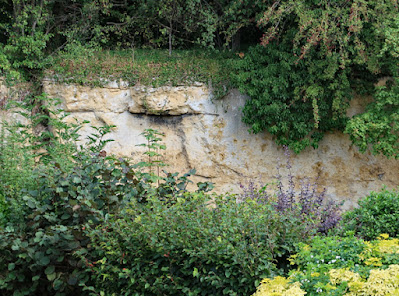When setting out to photograph Castle Hill Farmhouse, during my exploration of the historic architecture of Hickleton, I had a wander around Lady Mary View to see if I could get a good view of the old quarry face to Castle Hill Quarry, which borders the back gardens of several houses on the modern housing estate.
Back in 1997, I had briefly visited the estate when undertaking surveys of potential RIGS (Regionally Important Geological Sites) in Doncaster and recorded the presence of sandy brecciated beds, which had been eroded to leave a distinct overhang.
On this occasion, I couldn’t see much of the quarry face from the roadside but, when my curiosity led me down a path that I found on Lady Mary View, I could see a section of massive limestone in the Wetherby Member of the Cadeby Formation.
The outcrop of the Cadeby Formation here forms a distinct elongated spur, which would have made it an obvious location to quarry building stone. Making my way further along the path, I soon came to another part of the quarry face where the section mainly comprises beds of massive limestone, with thinner beds in its upper parts.
A little further along the quarry face, I came across a well developed rift in the rock face, of a type that I had seen before along the Don Gorge and at Barnburgh Crags, when undertaking the Doncaster Geodiversity Assessment back in 2007. I didn’t take the time to examine it closely, but I didn’t see an infill of Quaternary sand and gravel, which is commonly associated with these rifts and often contains the bones of mammals.
In the upper part of the exposed quarry face, the massive limestone is overlain by a very sandy bed that is orange in colour and is differentially weathered. Further along the quarry face, the yellow/orange sandy limestone is much thicker and, as shown by the development of scouring and cavities, is much less resistant to weathering than the typical buff coloured dolomite.
The geological memoir records a 7 metre section, which describes the limestone as mainly oolitic, with variable grain size, texture and colour and mentions that various bivalves, brachiopods and bryozoans have been found; however, it makes no mention of the yellow to orange colour variation of the softer beds, which I immediately noticed.
Although I did not have my Estwing hammer with me, using a large lump of stone that was lying on the ground, I managed to obtain a small sample from one of the thin beds. The body of the stone is buff in colour with yellow colouration on the bedding planes. Its texture is dense and finely granular, without the voids or vughs seen in the sample taken from the wall alongside Barnsley Road and it also contains black specks that are probably a manganese oxide mineral.
The distinct yellow colouration of the Cadeby Formation usually occurs only at exposures where the limestone is seen to rest on the Yellow Sands Formation, which are regarded as the local remains of aeolian deposits filling hollows in the pre-Permian landscape.
The Yellow Sands Formation is not marked on the geological map of the area around Hickleton, although it does occur along the Magnesian Limestone escarpment as a small outcrop 5 km, to the south-east at High Melton, with more extensive exposures 1 km to the north at Bilham Sand Pits and Watchley Crags.
The archaeologist J.R. Magilton, quoted on p.37 of the Doncaster Character Zone Descriptions section of the South Yorkshire Historic Environment Characterisation project, considers that Castle Hill Quarry is “perhaps contemporary with the estate village”, which would date it to the C17 rather than the C12, when St. Wilfrid’s church was built.
Although I have seen several churches that incorporate some yellowish limestone, St. Wilfrid’s church and particularly St. Peter’s church in nearby Barnburgh, are the only churches in South Yorkshire that are built entirely with yellow limestone. This raises the question of the quarry source of the limestone used to build the churches and the historic buildings in these villages.
When visiting Barnburgh Crags, also whilst undertaking the Doncaster Geodiversity Assessment, I was struck by the yellow colour and I thought that the crags had been quarried at its eastern end, at least. The Historic England Building Stones of England map, which is based on the up to date British Geological Survey maps, does not show any quarrying here but it does highlight the Hickleton Quarry, which supplied stone to the Hickleton Hall estate.
 |
| An extract from the Historic England Building Stones of England map |













No comments:
Post a Comment